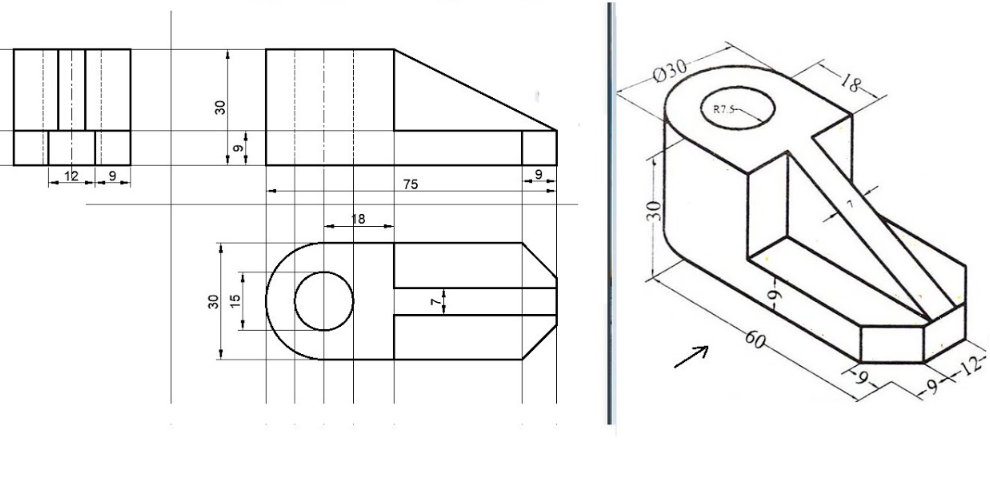The front sight is typically the most recognizable element of a technical drawing. The key goal of the front sight is to deliver a clear, uncomplicated representation of the item that emphasizes vital attributes, dimensions, and percentages.
Building upon this, the leading view enhances the front view by supplying details regarding the deepness of the object. This view permits designers to see exactly how wide and deep the item is, removing ambiguity that might emerge from the preliminary façade alone. The top view aids to visualize connections in between different aspects of the layout, making it easier to understand the design of parts, especially in elaborate systems with lots of overlapping components. When utilized efficiently, the top sight can aid communicate important elements of capability and spatial arrangement that are important for producing and setting up.
The side sight, additionally recognized as the account sight, uses yet one more point of view by illustrating the item's elevation and deepness. By integrating the side sight into the technical drawing, designers guarantee that all dimensions can be precisely provided, producing a detailed sight of the things.
Discover technical drawing views the essential role of technical drawing in engineering and architecture, highlighting key views such as front, top, side, section, and isometric perspectives that ensure accurate communication and execution in design and manufacturing.
Section views are another important component of technical drawings. They give a means to illustrate the interior functions of a design that might not be apparent from the exterior views. An area sight is produced by slicing through the things and revealing its interior geometry. This approach allows engineers and designers to discover intricate functions such as tooth cavities, shapes, and products within a layout. Consisting of section views assists to avoid confusion in recognizing the layout, particularly for elaborate assemblies where inner arrangements may affect functionality or manufacturability. By developing these cuts in the item, technical drawings become extra interesting, permitting more thorough analyses of exactly how components will certainly engage once assembled.
Another beneficial technique in technical drawing is isometric forecast. This sight uses a three-dimensional representation of the things, offering a useful impression of depth and range without needing complex viewpoint estimations. Isometric views can be extremely advantageous in sharing the general layout of a things, specifically to individuals who might not be well-versed in reviewing technical illustrations. While isometric projections disappoint representing real point of view, they remain a preferred option for presenting concepts clearly and not surprisingly. This makes them especially helpful throughout the early design phases when feedback and repetitive enhancement are crucial.
In enhancement to these basic views, there are various other types of forecasts, such as orthographic and point of view estimates, that offer different functions in technical drawing. Orthographic projections are a collection of several views that individually represent the object from different angles, normally in a two-dimensional layout.

To effectively produce a technical drawing, it is vital to comprehend the conventions and signs that represent different features and dimensions. Inaccurate dimensions can lead to costly blunders throughout production, making this aspect of technical drawing essential for dependability and success.
Numerous software application devices and applications help with the technical drawing process, enhancing the traditional hand-drawing approaches. Programs like AutoCAD, SolidWorks, and various other Computer-Aided Design (CAD) software program enable individuals to produce intricate 2D and 3D models with much better accuracy and versatility than manual techniques. These devices make it possible for very easy adjustments, permitting rapid prototyping and model without the demand to recreate illustrations from the ground up. This digital transformation has actually dramatically sped up the style and production procedures throughout many markets, driving innovation and enhancing performance.
In the context of markets today, understanding just how to use different views in technical drawing is not just vital for engineers and designers but additionally for makers, product designers, and also marketing professionals. The ability to connect complicated ideas merely and plainly through these visual representations helps to straighten teams, from concept via to production. In joint atmospheres, particularly in areas like building and production, clear technical illustrations ensure that all stakeholders-- from developers to clients-- are on the very same page. This cooperation is necessary for mitigating errors and lowering waste, eventually preserving time and sources while fostering creative thinking in the advancement of originalities.
With the rise of 3D printing and additive production, the value of precise technical drawing ends up being also much more obvious. As these technologies proceed to evolve, they need detailed specs to make certain that physical designs properly embody the initial design. The capability to from thorough technical drawings, consisting of multiple views, is necessary for creating components that not only fit together appropriately but additionally operate effectively as component of wider systems. In addition, as industries shift to computerized and digital procedures, the abilities needed to create and analyze technical drawings will certainly be critical to future skill pipes.
In final thought, technical drawing incorporates various views, each of which plays a particular function in sharing necessary info concerning a things. These perspectives-- including front, top, side, area, and isometric views-- aid to communicate complicated concepts and promote understanding among experts throughout numerous industries. As technology and techniques for developing technical drawings remain to development, understanding and carrying out these views properly remains critical. Not only does this improve clearness and performance in the layout and production worlds, but it also fosters development, permitting the effective understanding of imaginative principles and remedies. As we move even more into an age defined by quick technical advancement, the concepts of technical drawing and its associated views will most certainly remain vital in shaping the future of engineering, production, and design. Whether in traditional contexts or cutting-edge applications, the significance of effectively representing concepts will just expand, enhancing the demand for efficiency in this necessary ability set.